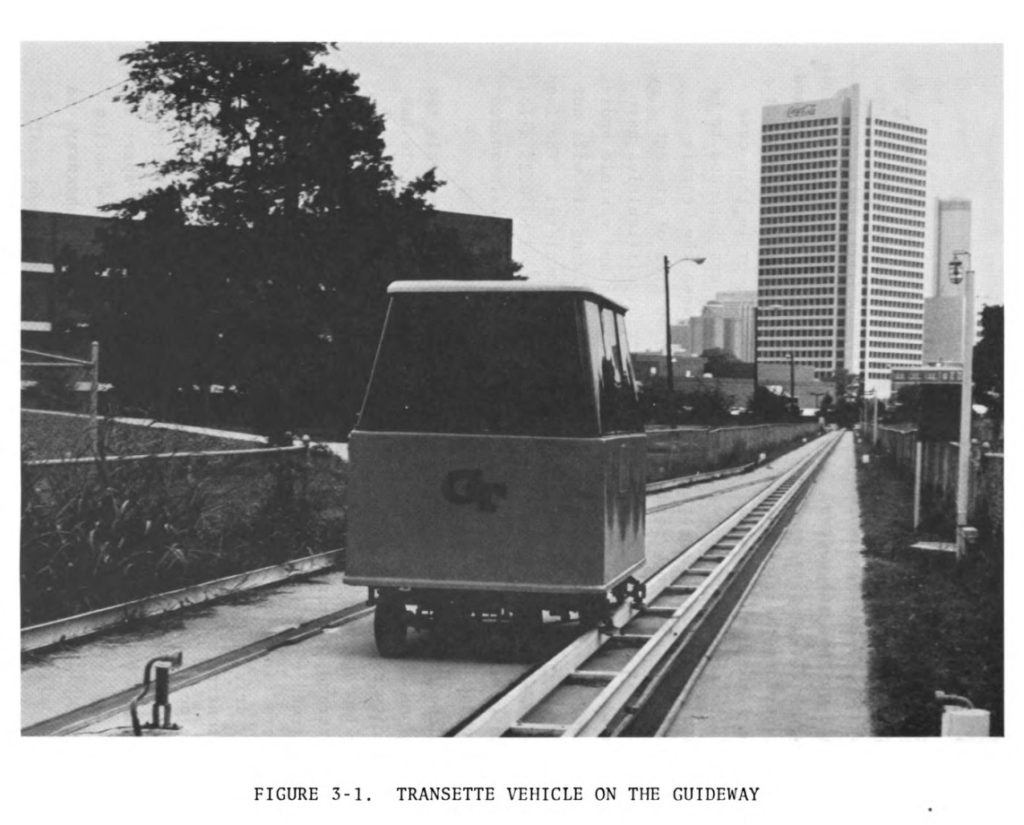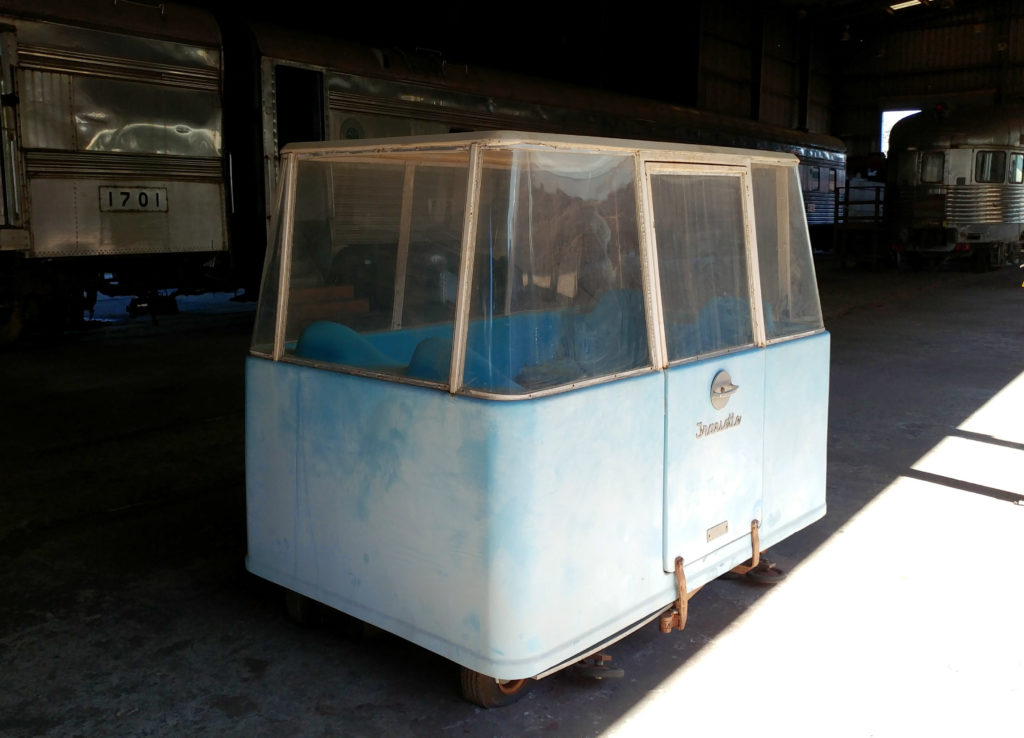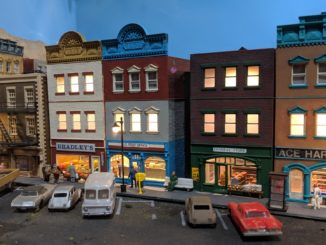
A Quirky People Mover with Big Dreams
Kristen Fredriksen and Duncan Carel
From 1974 to the early 1980s, a unique personal rapid transit system ran on the campus of the Georgia Institute of Technology but was never opened to the public. Called the Transette, the system underwent years of development and testing, but ultimately, delays and a lack of funding shut the project down.
Research into personal rapid transit possibilities intensified in the 1960s and 1970s with the signing of the Urban Mass Transportation Act of 1964 and the creation of the Urban Mass Transportation Administration (now the Federal Transit Administration). Cities sought a way to more efficiently transport small groups of people (and goods) in vehicles that took up less space, arrived more frequently, and could make better point-to-point connections. The lightweight vehicles would travel on guideways between stations, stopping as requested by passengers. A major advantage to these types of systems was that they “allowed vehicles to wait for people rather than forcing people to wait for vehicles,” according to Boeing.
The Transette’s belt-driven passive vehicle system was invented by Dr. J.F. Sutton while he was employed by Lockheed Aircraft Corporation. Lockheed was not interested in developing automated transportation at the time, and the invention was released to Dr. Sutton (U.S. Patent No. 3,690,367). Transette, Inc. was formed in 1972, and two years later, Georgia Tech was issued a grant from the National Science Foundation (NSF) to install and test the Transette system using Transette, Inc. as a subcontractor.
The Transette was “intended to fulfill the need for a system that [could] furnish effective, low-cost transportation of people over moderate distances in high pedestrian traffic areas” according to the 1977 Final Report of Verification Testing, and per some optimistic accounts, the Transette may have eventually even replaced automobiles on campus for everyday use. Others saw applications of the Transette system at airports, shopping centers, condominiums, parks, and more. A .25-mile test loop was built on the campus of Georgia Tech from the Student Center to a nearby parking lot between 1974 and 1976. The Transette system was autonomously controlled using a series of solid state logic computers; some of the controls developed for the Transette paved the way for other autonomous transit systems used today. The vehicles were propelled by a conveyor belt-like system under a drive wheel, which, using gearing and a clutch, made it possible for the vehicle to travel twice the speed of the belt. Each fiberglass-and-steel vehicle held four passengers and the theoretical maximum capacity for Phase I was about 900 passengers per hour. The Transette had a top speed of 15 mph (avg. 12.4 mph). According to Joe Ledlie, the “patchwork prototype” looked like “a glorified golf cart cruising along a baby roller-coaster track.” It became operational in October of 1976 and underwent an initial round of testing before funding ran out.
A .25-mile test loop was built on the campus of Georgia Tech from the Student Center to a nearby parking lot between 1974 and 1976. The Transette system was autonomously controlled using a series of solid state logic computers; some of the controls developed for the Transette paved the way for other autonomous transit systems used today. The vehicles were propelled by a conveyor belt-like system under a drive wheel, which, using gearing and a clutch, made it possible for the vehicle to travel twice the speed of the belt. Each fiberglass-and-steel vehicle held four passengers and the theoretical maximum capacity for Phase I was about 900 passengers per hour. The Transette had a top speed of 15 mph (avg. 12.4 mph). According to Joe Ledlie, the “patchwork prototype” looked like “a glorified golf cart cruising along a baby roller-coaster track.” It became operational in October of 1976 and underwent an initial round of testing before funding ran out.
Between 1976 and 1979, a number of delays stalled the project until a modification program intended to tackle some of the Transette’s problems was funded in mid-1979. Tests were then carried out on the system by a number of different organizations, including the NSF and the U.S. Department of Transportation. Of the planned eight original Transette vehicles, just two were built during the initial phase. The system never carried passengers due to safety concerns and performance and reliability issues. Even after the modifications, it was concluded that without major changes, the system was unsuitable for use. Over the course of the project, the costs of building and evaluating the Transette system rose to a total of $685,500 (about $3.5 million today).
Soon after funding dried up and interest dwindled, the system was dismantled and scrapped. The only known surviving bit of this personal rapid transit system is a single Transette car, currently on display at the Southeastern Railway Museum in Building 2.
The Transette was donated to the Southeastern Railway Museum in 2004. The museum’s status as “The Official Transportation History Museum of the State of Georgia” and a conversation between Dr. Michael Meyer, Chair of the Georgia Transportation Institute of the Georgia Tech School of Civil and Environmental Engineering, and graduate student Paul Grether resulted in the donation. Dr. Meyer had been placed in charge of the Transette vehicle and it was placed in temporary storage at the Mason Building on campus. As a result of the conversations, it was agreed that the Museum would take over and display the Transette to document the artifact of the public transit research on the Georgia Tech campus that took place in the late 1970s and early 1980s by Dr. Frank Sutton and others.
The Transette was moved by Paul Grether and Nick Henderson to SRM in 2004.
Today, only a few personal rapid transit systems are operational. The largest and longest-running system can be found at West Viriginia University in Morgantown, West Virginia, where over 15,000 passengers ride the system each day.
————————————————————————–
More historic photos and articles: Paul Grether, Flickr
Further reading:
Boeing: Personal Rapid Transit | Historical Snapshot
Final Report: Verification Testing of the Transette Personal Rapid Transit System (March 1977)









Be the first to comment